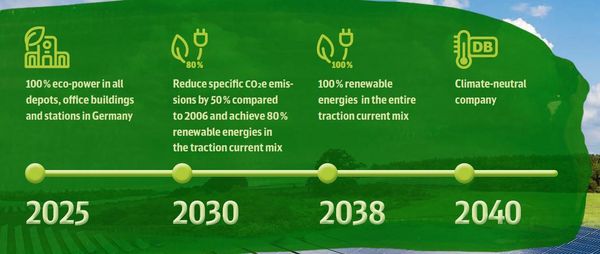Climate protection
Our contribution to climate protection
Germany and Europe’s climate protection targets can only be achieved if there is a shift in mobility towards a strong rail. For this reason, we have brought our own climate protection target forward by ten years: we aim to be climate-neutral by 2040. Compared with other modes of transport in Germany, only rail has made a consistently positive contribution to climate protection since 1990. Over the past 30 years, we have made a significant contribution to climate protection by reducing CO₂ emissions by about 70%. On the path to climate neutrality, we have set ourselves ambitious milestones-
Management approach and climate protection target
We are seeking to create incentives to shift traffic towards rail. Achieving a shift in the mode of transport is key to meeting Germany’s climate protection targets in the transport sector. Even as the transport sector moves towards electrification, the low levels of friction generated by wheel-rail contact mean that rail travel will continue to be the most efficient form of energy use.
In 2020, the Science-Based Targets Initiative (SBTi) pro - vided us with scientific confirmation that: our targets for reducing greenhouse gas emissions contribute to achieving the goals of the Paris Climate Agreement. In 2021, we made our climate protection target even more ambitious, and want to become climate-neutral by 2040. This means that we intend to achieve our climate protection target ten years earlier than previously planned. Our target year is therefore five years ahead of the Federal Government’s target year for the climate neutrality of Germany. In line with our strategic focus, the greenhouse gas emissions from DB Arriva’s business operations are no longer factored into DB Group’s climate protection target. Nevertheless, DB Arriva has also set itself the target of becoming climateneutral by 2040.
In order to achieve our climate protection target, we have laid out a number of ambitious milestones: by 2030, we will have more than halved specific greenhouse gas emissions (i.e. emissions in relation to performance figures such as volume sold) worldwide compared to 2006. Within Germany, the implementation of the Strong Rail strategy and transport policy measures could help to achieve a noticeable shift in the mode of transport by 2030. This and other measures in rail transport could also save up to 10.5 million tons CO₂ in the transport sector in Germany per year.
We plan to increase the share of renewable energies in the DB traction current mix in Germany to 80% by 2030. By 2038 at the latest, we intend to have fully converted DB train operating companies in Germany to eco-power. In our buildings and stationary facilities, we have also started to switch the power supply to renewable energy sources. From 2025, all of our depots, office buildings and Stations no. 147 in Germany will be fully eco-powered.
The expansion of renewable energies also entails challenges. Instead of a small number of large fossil-fuel power plants with a constant supply, we need to upgrade our infrastructure to accommodate an increasingly decentralized energy supply from smaller, renewable electricity producers with a variable output. The LuFV enables us to carry out necessary infrastructure measures in the traction current grid. DB Netze Energy, for example, will set up seven new converters by 2028. We also use sensors and AI so that we can continue to manage the increased complexity of the traction current grid in future with high supply reliability
Greenhouse gas intensity
SPECIFIC CO₂e EMISSIONS IN COMPARISON TO 2006 / % | 2021 | 2020 | 2019 | |
DB Group | – 36.1 | – 34.4 | ‒34.8 | |
2021 excluding DB Arriva.
Excluding fleet vehicles, DB Schenker stationary divisions, DB Arriva and individual divisions of DB Cargo.
The share of renewable energies in the DB traction current mix in Germany is not the only measure by which we manage our progress in climate protection. We also track the development of our specific greenhouse gas emissions in comparison to 2006.
As part of our Group climate protection target, we were able to further reduce specific greenhouse gas emissions and are therefore significantly ahead of our forecast from the 2020 Integrated Report. Our absolute greenhouse gas emissions have increased again following a sharp decline resulting from Covid-19, but are still well below the level of 2019.
Outlook
| ANTICIPATED DEVELOPMENT | 2021 | 2022 | |
| Specific greenhouse gas emissions in comparison to 2006 (%) | –36.1 | ‒39 | |
- Due to the continuing impact of the Covid-19 pandemic, in particular on passenger transport, our expectations of further reducing specific greenhouse gas emissions in 2022 are subdued compared to 2006.
